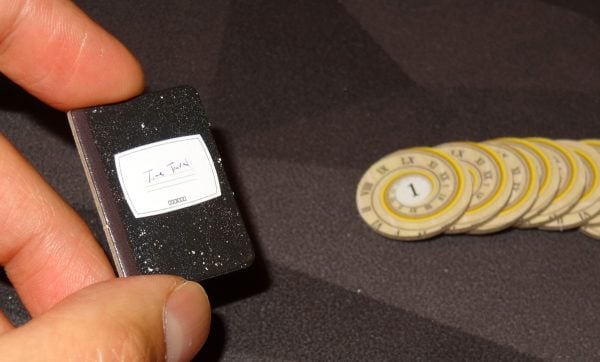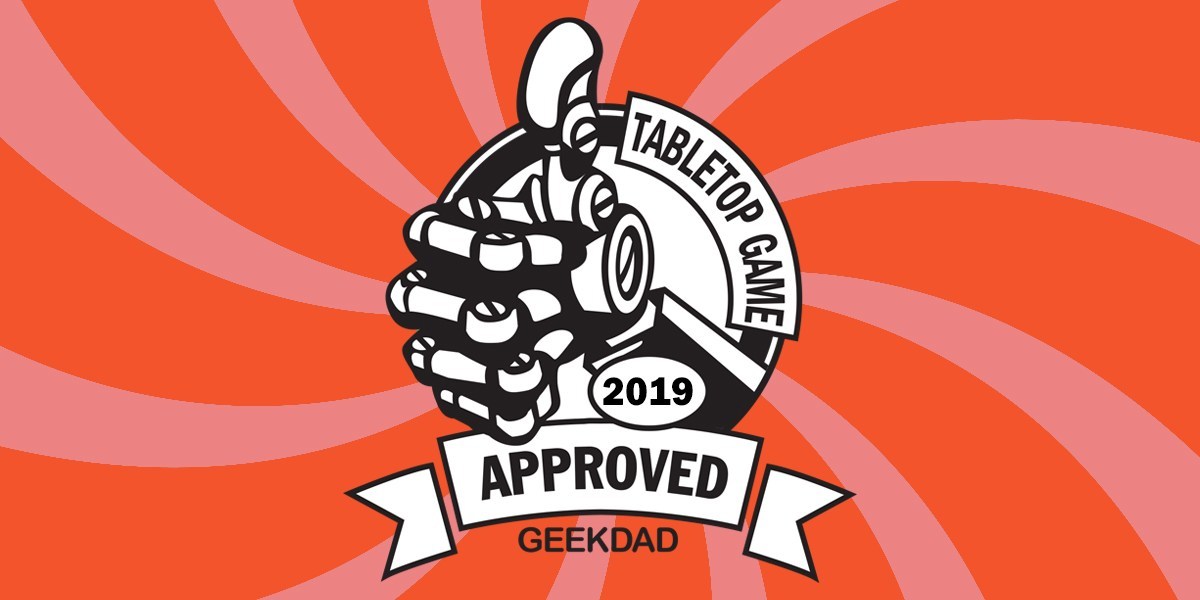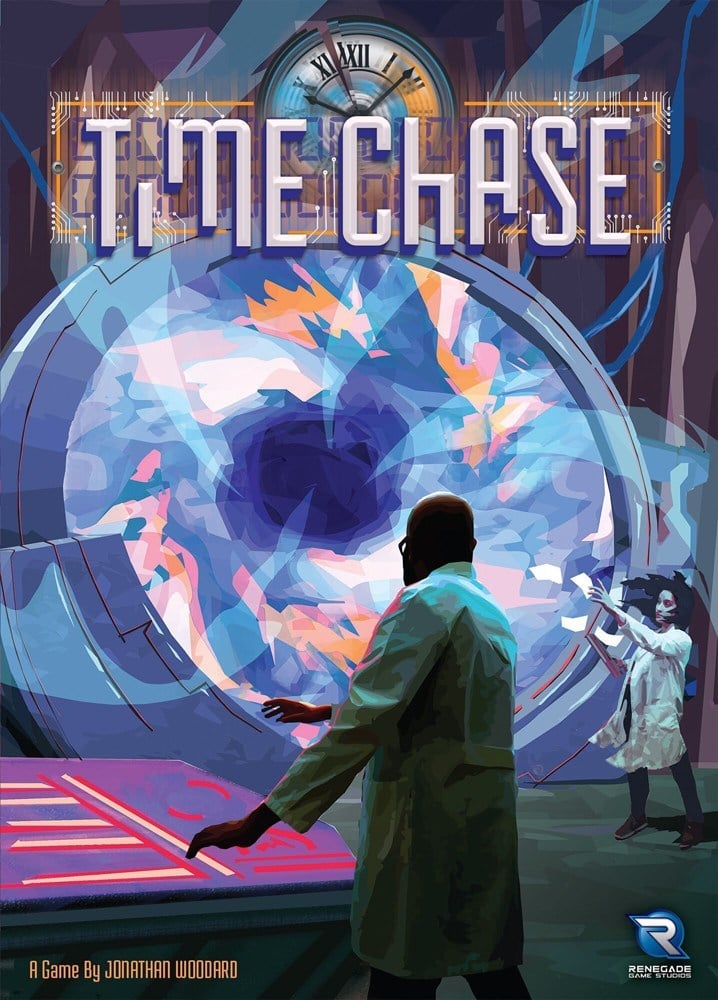 You’ve invented a time machine—but your colleagues are trying to go back in time and take the credit for themselves! (Or maybe that’s what you’re doing?) At any rate, it’s time for a Time Chase!
You’ve invented a time machine—but your colleagues are trying to go back in time and take the credit for themselves! (Or maybe that’s what you’re doing?) At any rate, it’s time for a Time Chase!
What Is Time Chase?
Time Chase is a trick-taking game for 3 to 6 players, ages 10 and up, and takes about 30 minutes to play. It retails for $20 and is available directly from Renegade Games or in game stores now. The game is a mix of pretty traditional trick-taking rules (comparable to Spades) and non-traditional time-travel shenanigans. I think ages 10 and up should be able to learn it, though some familiarity with trick-taking games makes it a lot easier to learn.

Time Chase Components
Here’s what comes in the box:
- 65 Element cards
- 10 Event tokens
- First Player marker
- 30 Fuel Crystals
- 6 Traveler pawns
- 18 Control discs (3 per player)
- 6 Time Machine cards
The components are pretty simple—mostly cards, with a few extra components—and vary a bit from “meh” to “cool.” For instance, on the “meh” end of the spectrum, the fuel crystals are a standard plastic gem found in many games, and the control discs are just tiny cardboard discs that match the player colors. On the other end, we have the first player marker, a cardboard token that looks like a tiny composition book (complete with “Time Travel” scrawled across the front cover) and the individual traveler pawns that are differentiated by both shape and color. The event tokens are small cardboard disks (numbered 1 to 10) that look kind of like a swirling clock face: simple, but effective.
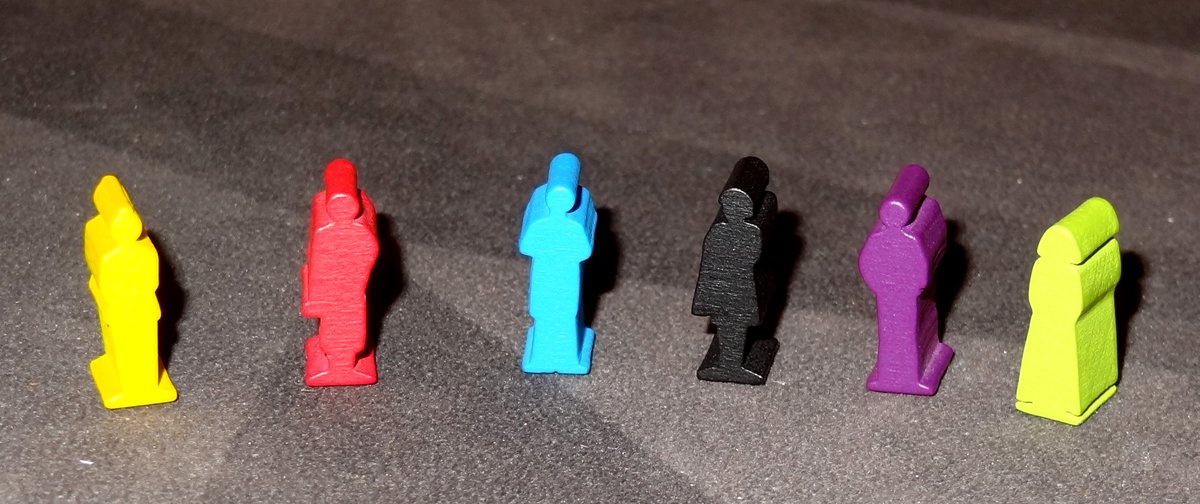
I like the fact that the pawns have unique shapes because that can also help for color-blind players (though these pawns are pretty tiny). The downside, though, is that these shapes aren’t represented anywhere else—the control discs and the time machines are distinguished only by color, so there’s no secondary indicator for color-blind players on those components.

The element cards are somewhere in the middle: they have colorful backgrounds that are easily distinguishable, accompanied by numbers and a suit icon in the corners, and the card backs have an orange border that seems a little out of place. The suits have names (Neutrinos, Dark Matter, Paradox, Tachyons, and Flux) but since those are listed in the rulebook and not on the cards themselves, we tended to refer to them by the icon color or shape instead (like “pink swirl”). The cards come in five suits and each suit includes values from 1 to 13. The typeface on the cards is not particularly inspired, and with no other game information on the cards, I think the numbers could have been a bit larger to make them even more visible from a distance.

The time machine cards are back on the “rudimentary” end of things. The cards are double-sided, labeled “A” and “B,” though the only difference is that A includes one large rectangle and B includes two (marked with a forward arrow and a backward arrow). There’s a small strip of color on the bottom of the card that indicates your player color, and three circles across the top where you store your crystals. Two of those are marked with a “minus crystal” icon: the idea is that as you remove your tokens, that serves as a reminder that you earn fewer crystals—but because the left-most circle doesn’t have the icon, players often remove that one first, thus missing the reminder. It’s kind of a strange layout. While the artwork is somewhat reminiscent of the portal on the cover, it’s been muted and shrunk down so much that it doesn’t really give a “time machine” impression at all.
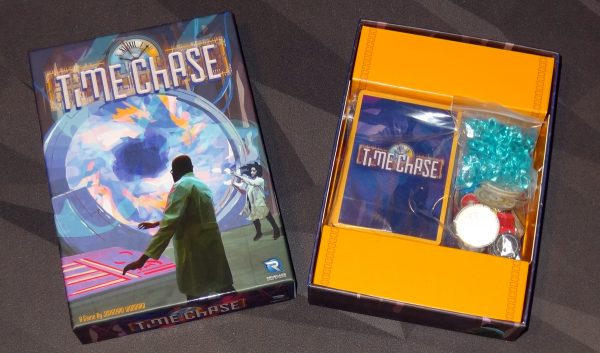
Overall component quality is fine, but not spectacular. The game doesn’t look like much, but fortunately (as you’ll see below) the gameplay makes up for that, and most of my complaints are about the aesthetics and not the usability. The biggest usability change I wish for is more crystals: in a 5- or 6-player game, it’s possible to run out, so you have to find some substitutes. The whole thing comes in a fairly small box—the cardboard insert uses that same incongruous orange.
How to Play Time Chase
You can download a copy of the rulebook here.
The Goal
The goal of the game is to control 3 events in the timeline at the end of a round by winning tricks.
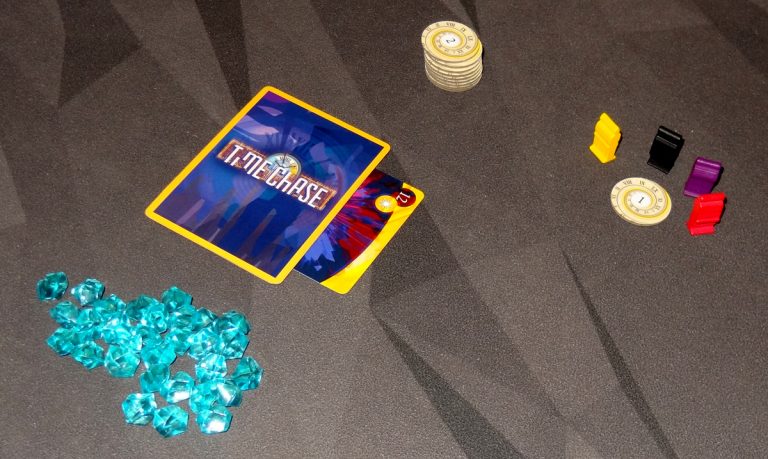
Setup
Give each player a time machine, 3 control discs, and the traveler pawn of their chosen color. The control discs are placed on your time machine slots.
Depending on player count, you’ll need to remove some of the cards (don’t forget to do this!). Then, shuffle the deck and deal 10 cards to each player. Set the rest of the deck aside, and then draw the top card and tuck it halfway under the deck—this card is the “invariant,” and indicates the current trump suit.
Set the crystals in a supply, and place the event tokens in order; place number 1 on the table near the deck to begin the timeline, and everyone places their pawns next to this event.
Give the first player marker to the player sitting to the left of the dealer.
Gameplay
We’ll start with an introduction to trick-taking, in case you’re not familiar with the genre. Time Chase follows a lot of classic trick-taking rules:
- For each trick, each player will play one card from their hand in turn order.
- You must play a card of the suit that started the trick if possible—this is called “following suit.”
- If you have no card of the starting suit, you may play any card.
- The winner is the hand that played the highest trump card; if no trumps were played, the winner is the hand that played the highest card of the starting suit.
- If you don’t follow suit and don’t play a trump card, then you will not win the trick, regardless of how high your card is.

A few rules particular to Time Chase:
- The invariant—the card tucked under the deck—is the trump suit, and it can be changed during the course of the game.
- If you follow suit but your card is lower than the current highest card of the starting suit, you earn 1 bonus fuel crystal immediately.
- After a trick is resolved, the starting card and the winning card are placed next to the event token (starting card on bottom, winning card on top, overlapping so you can see both). The winner places their control disc onto the event token. Any other cards played are discarded.
In the photo above: the cards were played in order from left to right. The starting card is 9 tachyons. The second player played 8 tachyons, so they earn 1 bonus fuel. The third player had no tachyon cards and played 4 paradox, which is the invariant (trump suit). The fourth player also had no tachyons and played 12 dark matter. The last player played 11 tachyons—even though it’s not winning the trick because of the trump card played by the third player, it is the highest card of the starting suit, so this player does not earn fuel. The winner of the trick is the third player, who played the highest card in the trump suit.
Okay, so far it’s a fairly normal trick-taking game. Here’s where things get weird.
On the first round, everyone will be at event 1 and play as normal. The next event token is placed in a row, and players automatically move there: this is the “present.” You also earn fuel: you earn 2 fuel by default, but 1 less for each of your control tokens that’s on the timeline. Then, before playing the next trick, everyone has an opportunity to spend fuel in their time machines to travel into the past.

Secretly place any number of fuel crystals onto your time machine card. Each fuel you spend will move you one event backward, and you can move as far as event “0,” which is the invariant itself. This is done in secret, and everyone reveals their time machines simultaneously. Unfortunately, there aren’t shields provided so you just need to use your hands to cover your card and fuel supply. All the spent fuel is discarded to the supply, and players move their pawns backward on the timeline to their new location.
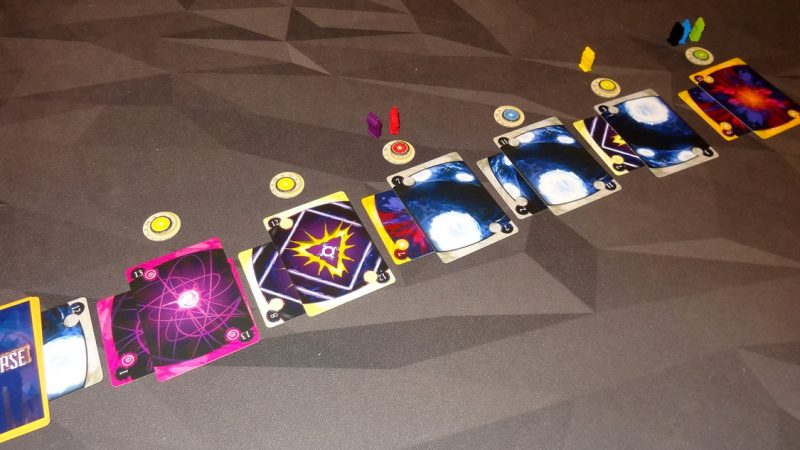
Now, each event (trick) in the timeline is resolved, one at a time, starting with the “present” and going backward into the past, until each occupied event has been resolved. You only play cards in a trick if you’re at that event, so it’s likely that only a portion of the players will be playing in any given trick. The present trick is resolved as usual; the starting player is the player who controls the previous event in the timeline. (If that player isn’t—ahem—present, then you pick the participating player closest to the player with the start player marker.)
For past tricks, you still have to follow suit if possible, as indicated by the cards that are in the timeline, and you can still earn bonus fuel as usual. If you beat the current winning card, then that card is discarded and you place your winning card in its place. You also remove the control disc and return it to its owner, and place your control disc onto the event token.
If you time travel all the way to the invariant, discard the current invariant card. Every player there secretly chooses a card, and they’re revealed simultaneously. The highest number played becomes the new invariant and is tucked under the deck. If there’s a tie for highest card, then all cards are discarded and there is no invariant. Note that changing the invariant does not alter the outcome of any of the events currently in the timeline, but it makes it possible to change their outcomes in future rounds.
When every event in the timeline has been resolved, a new event token is placed at the end of the timeline, and everyone snaps back to the present, earns fuel, and then a new round begins with players programming their time machines again.
Game End
The game ends when, at the end of a round, one player controls 3 events in the timeline. That player wins immediately.
Alternatively, if 10 rounds have been played and nobody controls 3 events, the player who controls the most events wins. In the case of a tie, the player who controls an event closest to the invariant (furthest in the past) wins.
Time Jumble Variant
If you’re ready for a different challenge, you can mix things up—literally. Shuffle up the event tokens face down and place them in a stack. When they’re revealed each round, they are inserted into the timeline in the right order, and everyone moves to this new “present,” but now there may be previously resolved events in the past and the future. You use the B side of the time machine, and when you spend fuel, you indicate whether you’re traveling to the past or the future by placing fuel in the corresponding box.
The rest of the game remains the same.
Time Chase is GeekDad Approved!
Why You Should Play Time Chase
First off, I’ll be clear: I’m a huge fan of time travel stories. I’ve written several Stack Overflow columns on the topic, and I’m even co-hosting a podcast that’s all about time travel. I’ve played several games that involve time travel (some good, some not so good), and although the theme of Time Chase isn’t really fleshed out at all and seems a bit thin, the way that time travel is implemented in the game is extremely well done.
I grew up playing some traditional card games, including Spades and Hearts, so I have a fondness for trick-taking games. Over the years, I’ve enjoyed seeing designers take that basic concept and create new tweaks: Pikoko lets you see everyone’s cards except your own; Diamonds adds some special abilities to the suits. Some modern trick-taking games are more complicated than others, with their own exceptions to how cards are played or how the winner or points are determined.
What makes Time Chase really click is that the trick-taking rules are very traditional: if you’ve played Spades, you’ll pick up on this portion of the rules right away. There aren’t any unfamiliar twists to how you figure out who won a trick. But then the time travel! It’s a small, seemingly simple addition that totally cracks open a new world of strategies available to you, and introduces another level of mind games you’re playing with your opponents.
First off, consider the decision about how far back to travel. Maybe you lost the previous trick because your last card in the starting suit was really low and you were forced to play it. Well, now that you don’t have any more of that suit, you could go back and play a trump card and win it easily! But maybe somebody else could do the same thing. Is it worth spending a little more fuel to go further back in time and avoid running into somebody else? The further you go back, the more fuel you expend—but (usually) the less likely other players have made the same investment.
The fuel is a little bit of a catch-up mechanic in itself. If you’re winning tricks and have control of events in the timeline, then you don’t earn as much fuel at the end of the round. And if you’re losing tricks (but following suit), then you’re typically earning bonus fuel. Those two facts combine to allow players who are behind more flexibility in choosing their next location.

The ability to go back and change the trump suit itself is also a lot of fun—but it gets more and more expensive the later you wait, and you still have to take into account that after you change it, you’ll still need to go back in time and then play the new trump suit on previous tricks. In the game pictured above, the trump suit was changed several times, eventually settling on tachyons. By this time in the game, people had traveled back and every event in the timeline was controlled by a tachyon card, which meant it was incredibly difficult to go back and win a trick from somebody else. (Not to mention the tachyon cards were running out.) I ended up winning the game with a fairly low card on the last trick simply because everyone was out of trump cards and most couldn’t follow suit.
Traveling back in time also comes with a risk. Players who currently control events in the timeline typically have less incentive to travel back in time: they already have control, and they likely have less fuel to spend anyway. But if everyone goes back to mess with previous tricks, there may not be many people left in the present to put up a fight. However, the game doesn’t end immediately when somebody gets 3 tricks—so if a player wins their third trick in the present, they might still lose control of events in the past before the round is over.
Time travel games are often really complex and confusing; to be fair, time travel is complex and confusing, so that generally seems appropriate. What sets Time Chase apart for me is how straightforward the mechanics feel, yet they allow for such remarkable situations. What if you could go back and play a different card on this trick? What if you changed the invariant to a suit that you have in abundance? What if you and another player showed up at the same time in the past, both hoping for an easy win? What if nobody stuck around for the present and everyone went to the past? The thing about time travel stories to the past is that they’re often about regret: you want to go back and do something differently, change an outcome. When you play Time Chase, you’ll make plenty of mistakes that you’ll want to go back in time to fix—but this time, maybe you’ll be able to!
I recommend Time Chase especially for those who are already fans of trick-taking games because it takes an old genre into the future (ironically, by going back to the past). If you look past the somewhat unexciting components, you’ll find it’s a wibbly-wobbly, 88-miles-per-hour, barrel of 12 monkeys!
Click here to see all our tabletop game reviews.
![]() To subscribe to GeekDad’s tabletop gaming coverage, please copy this link and add it to your RSS reader.
To subscribe to GeekDad’s tabletop gaming coverage, please copy this link and add it to your RSS reader.
Disclosure: GeekDad received a copy of this game for review purposes.
